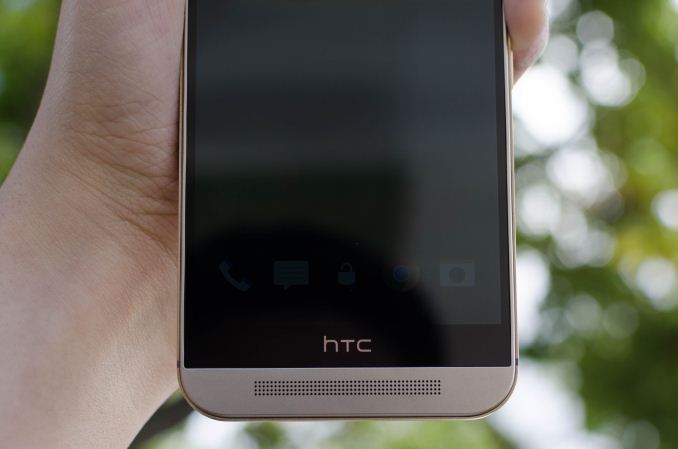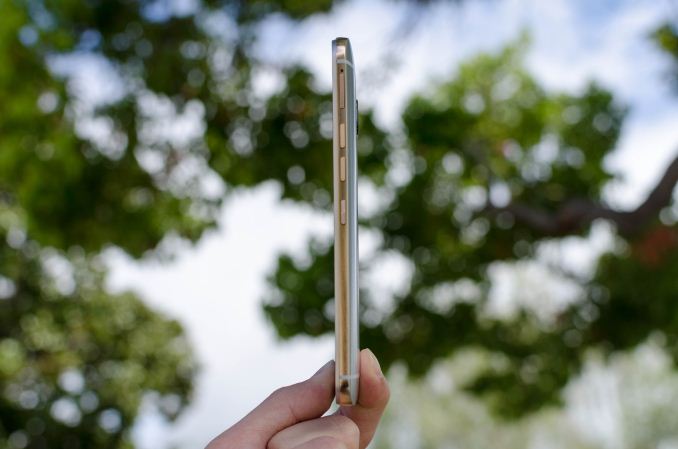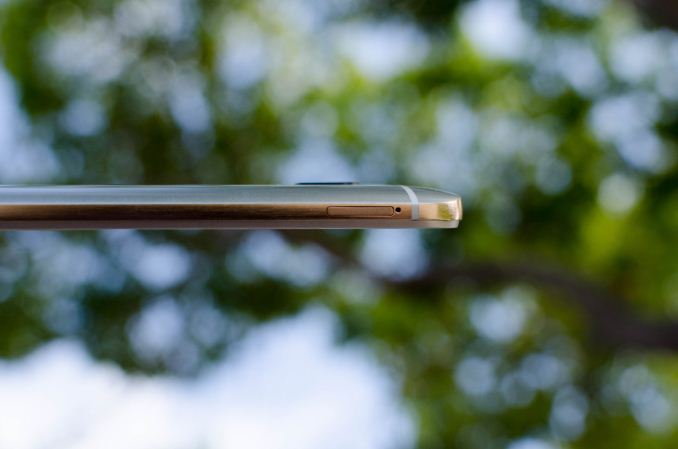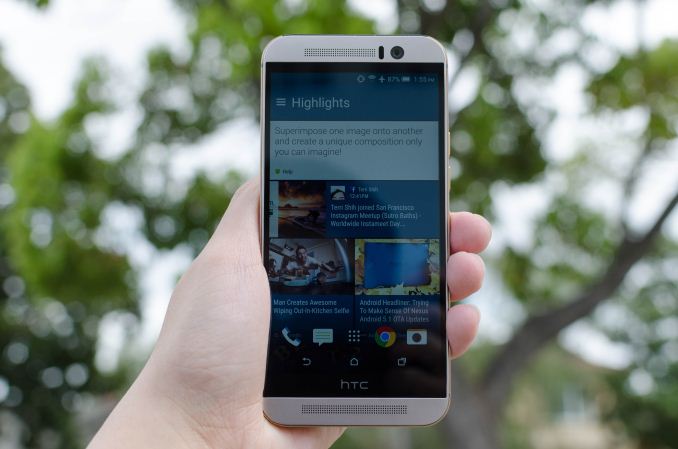The HTC One M9 Review: Part 2
by Joshua Ho on April 6, 2015 10:00 AM EST- Posted in
- Smartphones
- HTC
- Qualcomm
- Mobile
- Snapdragon 810
- One M9
Final Words
Now that we finally have all of the pieces together, we can come to some proper conclusions about the HTC One M9. For those that haven’t read part one of this review, it’s really necessary to do so to understand the context in which these comments are made.
There’s a lot to talk about here, so we’ll start with the design of the phone. HTC is probably the company best-known for design in the Android space, and with the One M9 it seems that they hope to capitalize on this by electing not to significantly change the design.
However, there are a few key changes to the One M9’s design when comparing it to the One M8. For instance, the One M9 moves the power button to the right side of the phone, changes the finish of the back cover, squares off the back cover, and replaces the front plastic bezel with a new plastic bezel. All of these changes seem to make some sort of sense at first, but they almost feel like a regression in some ways. The power button is on the side, but it takes a lot of effort to press it when the phone is held normally in the hand. However, it’s conveniently placed to accidentally press when picking the phone up from a table.
Meanwhile the back cover has a new finish and a neat dual-anodized color, but I question the value of these changes when they reduce yield and drive cost up, especially when sand-blasted anodized aluminum is comparable in look and feel. The continued use of the plastic bezel on the front also cheapens the feel of the phone. The new hard edges on the back cover is also quite uncomfortable, especially when compared to the M8’s smoother curve. There is also the issue of the “logo bar” bezel, but it’s physically impossible to get rid of this bezel due to engineering constraints.
The next aspect worth examining is the display. To HTC’s credit, a 1080p display at 5 inches is the right tradeoff to make with an RGB-stripe display. However, it’s concerning to see significant regressions in almost every area when comparing the display to the M8. An amazing display is almost a requirement for flagship smartphones at this point, and to see such a poor display with equally poor calibration is disappointing. It was clear in the past that HTC genuinely cared about delivering an amazing display, but somewhere along the way it seems that they forgot. We can speculate about the reasons behind this, but this is something that HTC has to fix if they want to remain relevant in the smartphone space, just like every other OEM at this point.
The other critical point of a smartphone is its ability to remain mobile. Battery life is probably the most important aspect of any smartphone, and a poor showing here can be enough to write off a phone. HTC has traditionally done quite well here despite using a smaller battery in their phones than average. Unfortunately, this isn’t true of the One M9. Despite using a newer SoC and a bigger battery, HTC regresses significantly in battery life when compared to the One M8. Although it seems that MIPI command mode has been removed from the One M9, it’s likely that most of the increased power draw can be directly attributed to the SoC, as the impact of panel self-refresh is relatively small.
Speaking of the SoC, the Snapdragon 810’s performance does generally provide a decent improvement over the Snapdragon 805, but it’s relatively little due to HTC’s governor settings which make it quite difficult to reach the maximum 2 GHz state. GPU performance is better than what we see on the Galaxy S6, but this is due to HTC’s choice to stay at a lower native resolution. At the same resolution, the Exynos 7420’s Mali T760 GPU is faster due to higher clock speeds. It’s also disappointing that HTC continues to use benchmark optimizations. The difference in performance is so small at this point that HTC should seriously consider removing these optimizations altogether, as it isn’t worth getting delisted from multiple benchmarks.
The camera of the One M9 is also a weak point, despite significant changes on HTC’s part in this area. Unfortunately, the post-processing here is just not acceptable, and the results of the camera are equally unacceptable. We will have to see how the camera performs without HTC’s heavy-handed post-processing when they update the camera to shoot in RAW, but HTC needs to improve dramatically here for next year.
The one positive note here is Sense 7, which continues to be one of the best experiences in Android overall. I fundamentally disagree with the assertion that a user should go to the Play Store to find various applications that they like, as taking this to its logical conclusion basically ends with having to download a dialer application from the Play Store on first boot. Blinkfeed continues to be a solid application for news, social media, and other information, and HTC’s apps in general are a strong point of differentiation judging by the demand from users to port them to non-HTC phones. However, I still think that HTC didn’t do enough for this iteration of Sense. Most of the applications still feel like they mesh best with Android 4.4, and overall the UI needs to be redesigned to fit with Material Design.
Overall, further testing of the One M9 basically confirms my fears, which were that the One M9 is effectively a sidegrade of the One M8 at best. I really did want to like this phone, as I still find the One M7 to be a great phone to use. I really wanted to see a phone from HTC that was worthy of an upgrade from the One M7, but the One M9 isn’t that phone. In fact, given that the One M8 is at least 200 dollars cheaper than the One M9 on contract, I find it incredibly difficult to recommend the One M9. It will definitely have its fans, but overall there are more negatives than positives. Given the competitive positioning of the One M9, the timing of the Snapdragon 810, and the strength of the Galaxy S6 I’m faced with an intense sense of déjà vu. It almost feels like we’re back where we started 3 years ago with the Sensation and Galaxy S2. I can't think of a better way to describe the situation HTC is in, which is alarming to say the least. The One M9 can't be another Sensation, but it feels like it is.














127 Comments
View All Comments
Dorek - Wednesday, April 8, 2015 - link
He probably means the life of the company? If they keep releasing phones this bad, they WILL go out of business.KiretoX - Monday, April 6, 2015 - link
I don't really understand why HTC first had a good idea and tried with 4Mpix and then instead of going in the middle between resolution and quality went right away to this terrible 20Mpix sensor? It would have been interesting if they went to something around 8-13Mpix... which is just fine resolution-wise. So now they first failed with low 4Mpix and now again failed with the super high 20Mpix...Laxaa - Monday, April 6, 2015 - link
It really seem slike they just rushed as far as they could in the opposite direction when deciding the specs for this camera. Ultrapixels was a good idea and a middle ground would have been nice. Maybe something like the iPhone 6 but with OIS.How large would the pixels be on a 8.3 MP(4K capable), 1/2.3 sensor be?
pjcamp - Monday, April 6, 2015 - link
HTC doesn't have the market share to request a custom sensor like Apple. They have to work with whatever standard parts are available off the shelf.melgross - Monday, April 6, 2015 - link
Yes, and they could,d have gotten an 8MP sensor off the shelf, or. 12-13MP version, or even a 16MP. They didn't need to go all the way to 20.It almost seems as thought they didn't even look at the specs, just the pixel count. And then they got rid of the camera processor as well. Very bad move.
Dorek - Wednesday, April 8, 2015 - link
"And then they got rid of the camera processor as well. Very bad move."Yeah, this is ridiculously stupid. I had a dumbphone in 2008 (the Motorola Zine) that had a separate imaging co-processor, and as a result it had autofocus times and shot-to-shot times on par with any 2015 smartphone. An imaging co-processor goes a LONG way.
LordConrad - Friday, April 17, 2015 - link
I would have preferred an 8 Ultrapixel camera on the M9. More incoming light and plenty of pixels for a phone camera.sinPiEqualsZero - Monday, April 6, 2015 - link
I'm sad to see this. Did no one at HTC use the phone before releasing it? I was hoping the M9 would be my new Windows phone later in the year.May need to switch to Android if no good flagships come out...perhaps the G4.
Thanks for the thorough review, Josh.
J4ckb1ng - Monday, April 6, 2015 - link
HTC's are Android phones. Me, I'm happy the M9 is not vastly different from the HTC M8. The M8 is my first smartphone and I don't regret my decision. I wish the M8 battery life were longer, but I'm glad overall that I have no urgent need to ditch the M8 for the M9.Refuge - Monday, April 6, 2015 - link
HTC Phones are also Windows phones. They have the flagship M8 in windows flavors, go look.If the M8 is your first smartphone I can see why you love it, it does feel premium and it is a good phone. Better than this M9 is if you ask me. But I honestly still feel that the ONE M7 was by and far the best phone of their ONE Mx lineup.
I'll definately be keeping this phone for the time being, HTC has nothing worth upgrading to if you ask me right now.